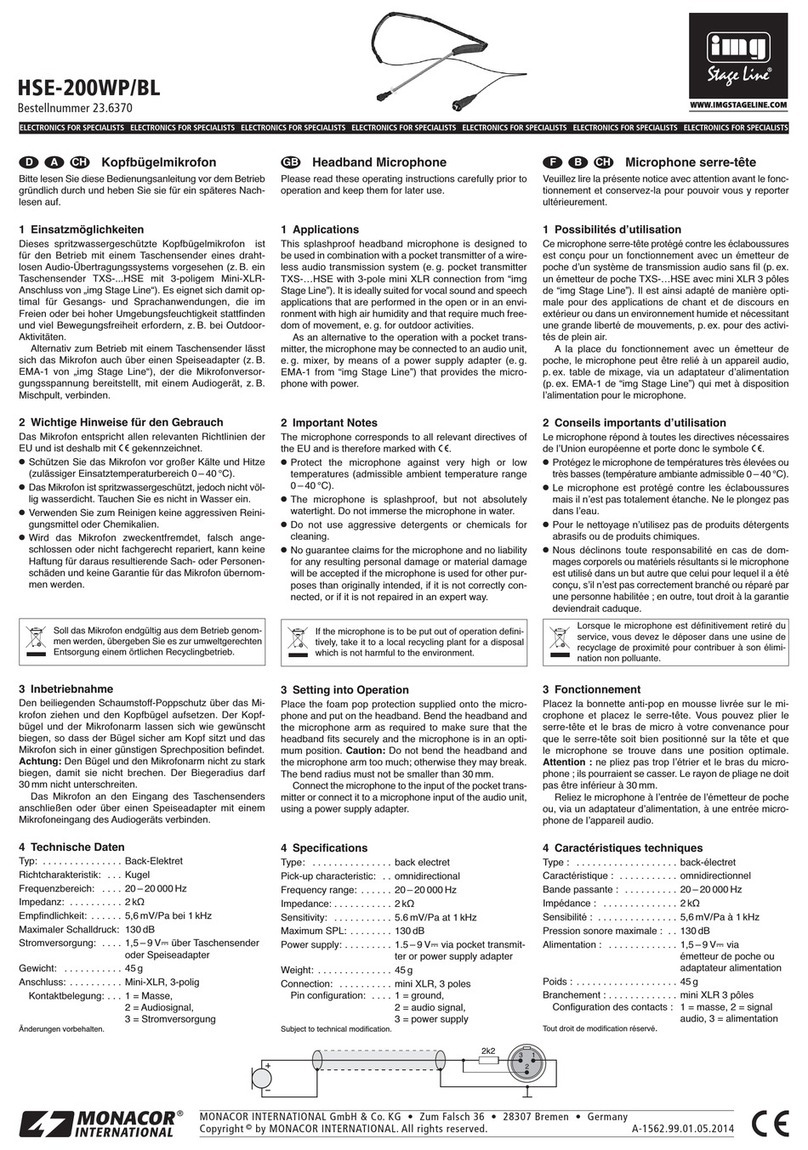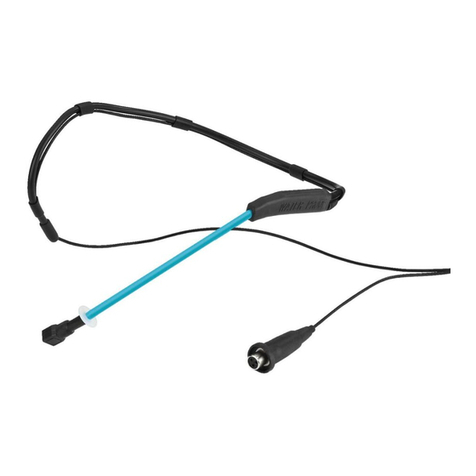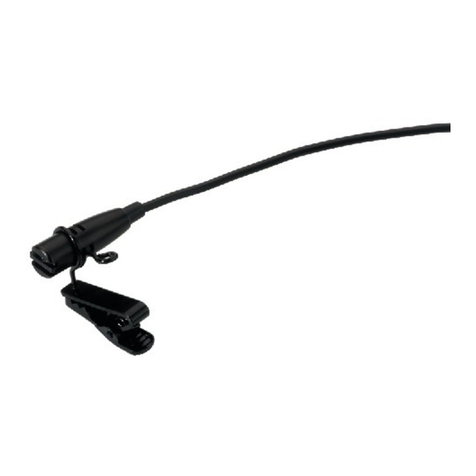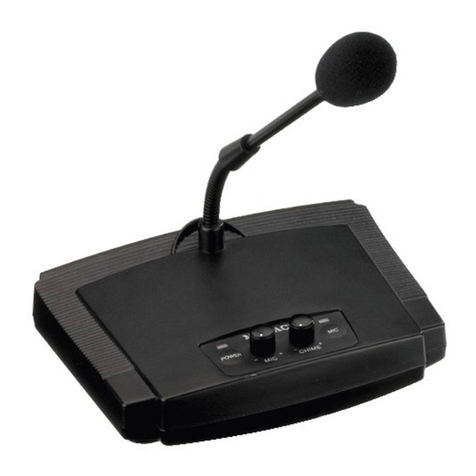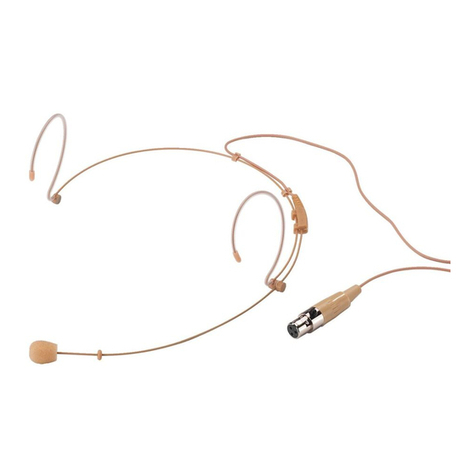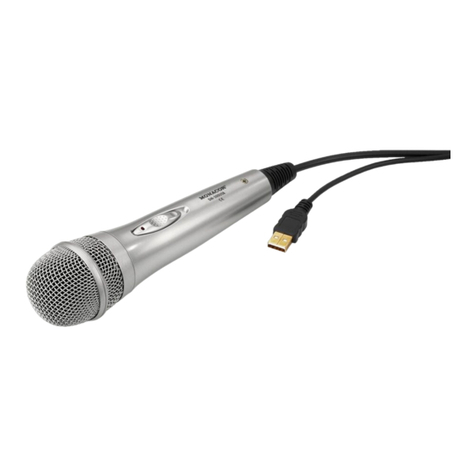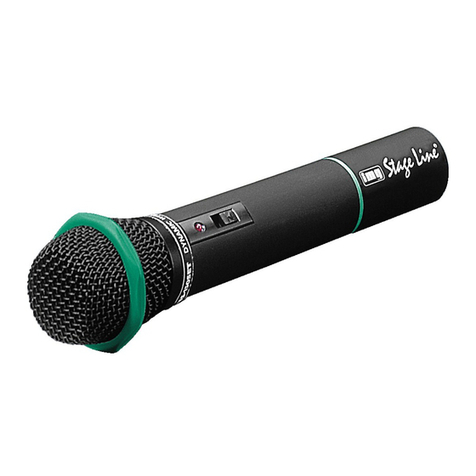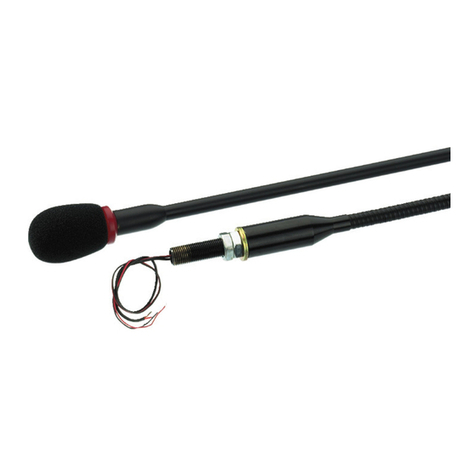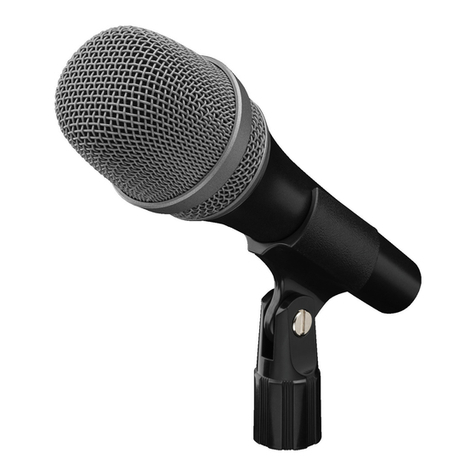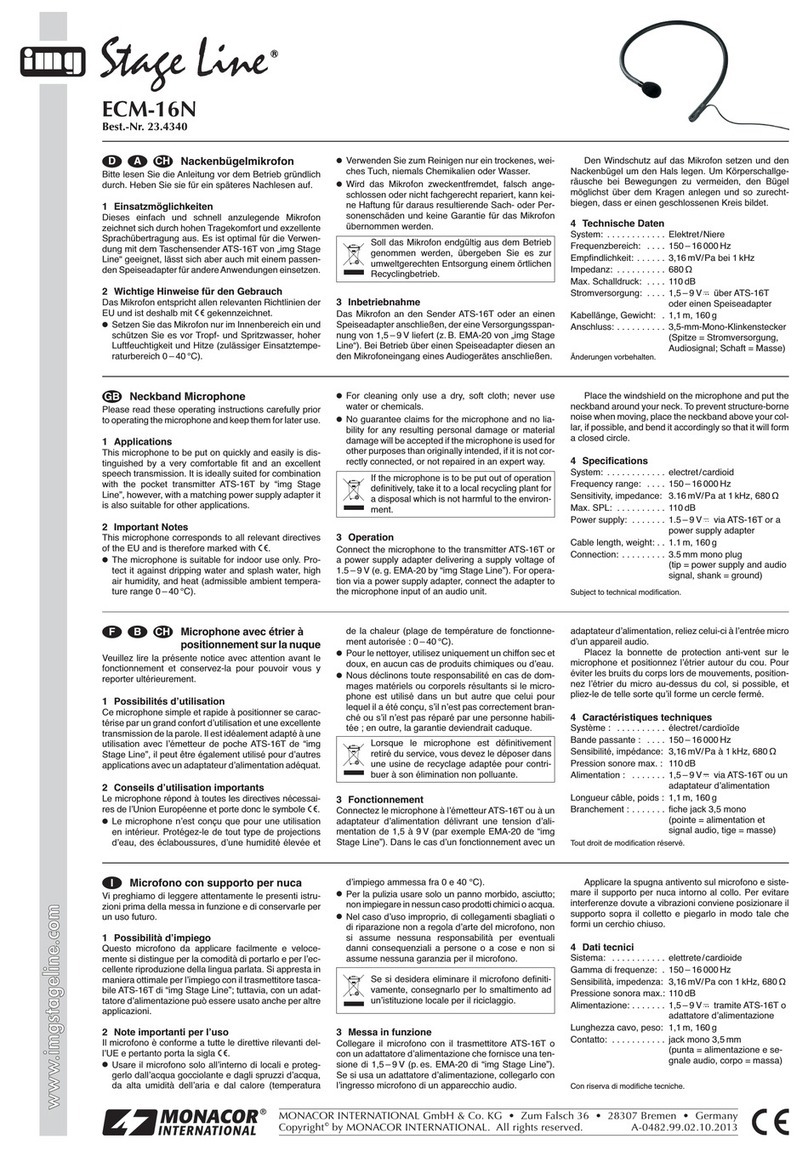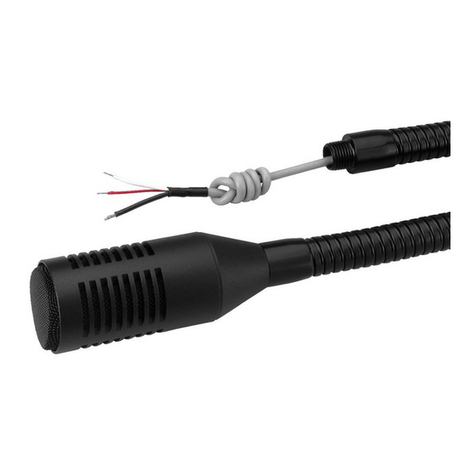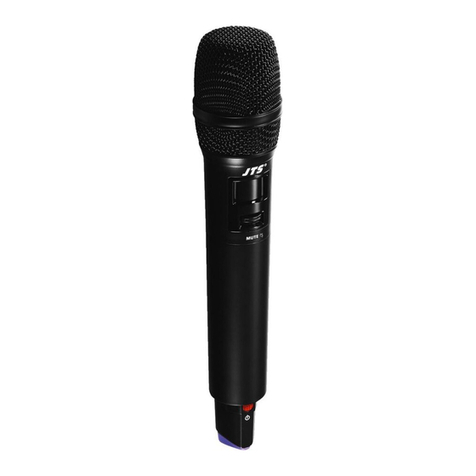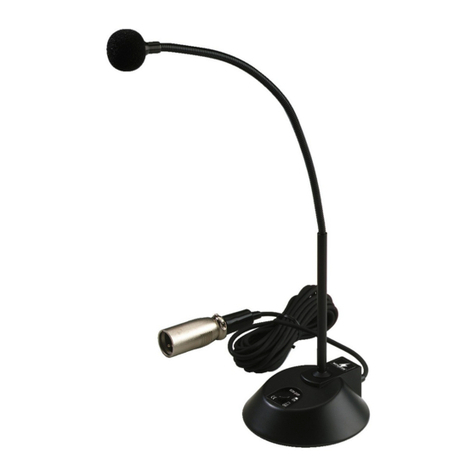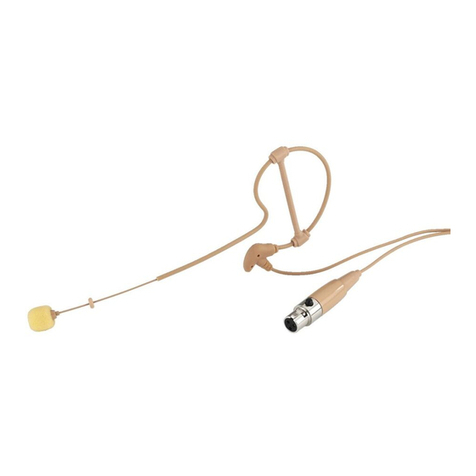➀Richtcharakteristik bei 1kHz
Pick-up pattern at 1kHz
Directivité à 1kHz
Frequenzgang
Frequency response
Réponse en fréquences
Großmembran-
Elektret-Mikrofon
1 Einsatzmöglichkeiten
Das Mikrofon ECM-110 mit extrem dünner, goldbe-
schichteterMembranistfürprofessionelleStudio-und
Live-Einsätze konzipiert und eignet sich sowohl für
dieSchallabnahme von Instrumenten alsauch für Ge-
sangs- und Sprachanwendungen. Zum Betrieb benö-
tigt das Mikrofon eine Phantomspeisung von 48V .
Zum Lieferumfang gehören ein abschließbarer
Koffer (inkl. 2 Schlüsseln), ein Mikrofonhalter (Spin-
ne), ein Ersatzband für die Spinne, ein Windschutz
und ein Schlüssel zum Aufschrauben des Mikrofons.
2 Wichtige Hinweise für den Gebrauch
Das Mikrofon entspricht der EMV-Richtlinie für elek-
tromagnetische Verträglichkeit 89/336/EWG.
●Setzen Sie das Mikrofon nur im Innenbereich ein.
Schützen Sie es vor Feuchtigkeit und Hitze (zuläs-
siger Einsatztemperaturbereich 0–40°C).
Large Diaphragm Electret
Microphone
1 Applications
ThemicrophoneECM-110withextra thin, gold-coated
diaphragm is designed for professional studio and live
applications and is both suitable for the sound pick-up
of musical instruments and for vocal sound and
speech applications. For the operation the micro-
phone requires a phantom power of 48V .
The microphone is supplied with a lockable case
(including 2 keys), a microphone support (spider), a
replacement ribbon for the spider, a windshield, and a
key for opening the microphone.
2 Important Notes
The microphone corresponds to the directive for elec-
tromagnetic compatibility 89/336/EEC.
●Themicrophone is only suitablefor indoor use. Pro-
tect it against humidity and heat (admissible
ambient temperature range 0–40°C).
●For cleaning only use a dry, soft cloth, by no means
chemicals or water.
●No guarantee claims for the microphone and no lia-
bility for any resulting personal damage or material
damage will be accepted if the microphone is used
for other purposes than originally intended, if it is
not correctly connected or not repaired in an expert
way.
3 Setting into Operation
1) Screw the spider onto a stand with 16mm (5/8")
thread or 9mm (3/8") thread. Place the microphone
into the basket support of the spider and screw it to
the support via its thread.
2) To align the microphone, release the setscrew at
the spider, position the spider with the microphone
inserted as desired and retighten the screw.
If the microphone is to be put out of opera-
tion definitively, take it to a local recycling
plant for a disposal which is not harmful to
the environment.
3) Connect the microphone via a cable with XLR plug
(e.g. a cable of the MEC series from “img Stage
Line”)to the microphone inputoftheaudiounitused
(e.g. mixer). The microphone input must have a
48V phantom power. If the audio unit does not pro-
vide any phantom power, connect the microphone
via an external phantom power supply unit (e.g.
EMA-3 from “img Stage Line”) to the audio unit.
4) If required, place the windshield.
4 Specifications
System: . . . . . . . . . . . . . . . . . pressure gradient microphone,
cardioid
Frequency range: . . . . . . . . . 20 – 20 000 Hz
Sensitivity, impedance: . . . . . 22.4 mV/Pa at 1 kHz, 200 Ω
Max. SPL: . . . . . . . . . . . . . . . 135 dB
S/ N ratio: . . . . . . . . . . . . . . . 83 dB
Power supply: . . . . . . . . . . . . phantom power 48 V
Connection: . . . . . . . . . . . . . XLR, balanced
Dimensions, weight: . . . . . . . Ø 54 mm x 200 mm, 550 g
Subject to technical modification.
Copyright©by MONACOR INTERNATIONAL GmbH & Co. KG, Bremen, Germany. All rights reserved. A-0429.99.01.06.2005
®
●Verwenden Sie für die Reinigung nur ein trockenes,
weiches Tuch, niemals Chemikalien oder Wasser.
●Wird das Mikrofon zweckentfremdet, falsch ange-
schlossen oder nicht fachgerecht repariert, kann
keine Haftung für daraus resultierende Sach- oder
Personenschäden und keine Garantie für das Mi-
krofon übernommen werden.
3 Inbetriebnahme
1) Die Spinne auf ein Stativ mit 16-mm-Gewinde (5/8")
oder 9-mm-Gewinde (3/8") schrauben. Das Mikro-
fon in die Korbhalterung der Spinne setzen und
übersein Gewinde mit derHalterungverschrauben.
2) ZumAusrichten des Mikrofons die Feststellschrau-
be an der Spinne lösen, die Spinne mit dem ein-
gesetzten Mikrofon wie gewünscht positionieren
und die Schraube wieder anziehen.
Soll das Mikrofon endgültig aus dem Be-
trieb genommen werden, übergeben Sie
es zur umweltfreundlichen Entsorgung
einem örtlichen Recyclingbetrieb.
3) DasMikrofonübereinKabelmitXLR-Stecker(z.B.
ein Kabel der MEC-Serie von „img Stage Line“) an
einen Mikrofoneingang des verwendeten Audio-
geräts (z.B. Mischpult) anschließen. Der Mikrofon-
eingang muss eine 48-V-Phantomspeisung auf-
weisen. Stellt das Audiogerät keine Phantomspei-
sung bereit, das Mikrofon über ein externes Phan-
tomspeisungsgerät (z.B. EMA-3 von „img Stage
Line“) an das Audiogerät anschließen.
4) Bei Bedarf den Windschutz aufstecken.
4 Technische Daten
System: . . . . . . . . . . . . . . . . . Druckgradientenempfänger,
Nierencharakteristik
Frequenzbereich: . . . . . . . . . 20 – 20 000 Hz
Empfindlichkeit, Impedanz: . . 22,4 mV/Pa bei 1 kHz, 200 Ω
Max. Schalldruck: . . . . . . . . . 135 dB
Signal-Rausch-Abstand: . . . . 83 dB
Stromversorgung: . . . . . . . . . Phantomspeisung 48 V
Anschluss: . . . . . . . . . . . . . . XLR, symmetrisch
Maße, Gewicht: . . . . . . . . . . Ø 54 mm x 200 mm, 550 g
Änderungen vorbehalten.
GB
ECM-110
Best.-Nr. 23.3570
wwwwww..iimmggssttaaggeelliinnee..ccoomm
D A CH
Microphone électret à
grande membrane
1 Possibilités d’utilisation
Le microphone ECM-110 avec une membrane extrê-
mement fine et un revêtement en or, est conçu pour
des utilisations professionnelles en studio et sur
scène et s’adapte aussi bien pour la prise de son
d’instruments que pour des applications de chant et
de discours. Le microphone nécessite, pour son fonc-
tionnement, une alimentation fantôme 48V .
Sont livrés un coffret verrouillable (avec 2 clés), un
support micro (araignée), une bande de rechange
pour l’araignée, une bonnette de protection et une clé
pour ouvrir le microphone.
2 Notes importantes
Lemicrophonerépond à la norme européenne 89/336/
CEE, relative à la compatibilité électromagnétique.
●Le microphone n’est conçu que pour une utilisation
en intérieur. Protégez-le de l’humidité et de la cha-
leur (plage de température de fonctionnement
autorisée : 0–40°C).
●Pour le nettoyer, utilisez uniquement un chiffon sec
et doux, en aucun cas de produits chimiques ou
d’eau.
●Nous déclinons toute responsabilité en cas de dom-
mages matériels ou corporels résultants si le micro-
phone est utilisé dans un but autre que celui pour
lequel il a été conçu, s’il n’est pas correctement
branché ou s’il n’est pas réparé par une personne
habilitée ; en outre, la garantie deviendrait caduque.
3 Fonctionnement
1) Vissez l’araignée sur un pied avec un filetage
16mm (5/8") ou un filetage 9mm (3/8"). Placez le
microphone sur le support de l’araignée et vissez-
le sur le support via son filetage.
2) Pour orienter le microphone, desserrez la vis de
réglage sur l’araignée, positionnez l’araignée avec
lemicrophoneplacécommesouhaité puis revissez
la vis.
Lorsque le microphone est définitivement
retiré du service, vous devez le déposer
dans une usine de recyclage adaptée pour
contribuer à son élimination non polluante.
3) Reliez le microphone via un cordon avec fiche XLR
(p.ex. un cordon de la série MEC de “img Stage
line”) à l’entrée micro de l’appareil audio utilisé
(p.ex. table de mixage). L’entrée micro doit possé-
der une alimentation fantôme 48V. Si l’appareil
audio n’a pas d’alimentation fantôme, connectez le
microphone à l’appareil audio via une alimentation
fantômeexterne (p.ex.EMA-3 de “imgStageLine”).
4) Sibesoin,mettez labonnettedeprotection en place.
4 Caractéristiques techniques
Système : . . . . . . . . . . . . . . . récepteur à gradient de
pression/ cardioïde
Bande passante : . . . . . . . . . 20 – 20 000 Hz
Sensibilité, impédance : . . . . 22,4 mV/Pa à 1 kHz, 200 Ω
Pression sonore max. : . . . . . 135 dB
Rapport signal/ bruit : . . . . . . 83 dB
Alimentation : . . . . . . . . . . . . alimentation fantôme 48 V
Branchement : . . . . . . . . . . . XLR, symétrique
Dimensions, poids : . . . . . . . Ø 54 mm x 200 mm, 550 g
Tout droit de modification réservé.
F B CH
